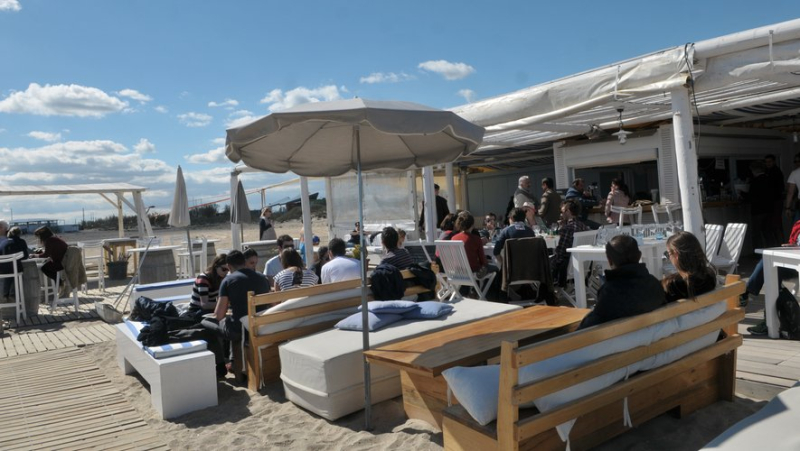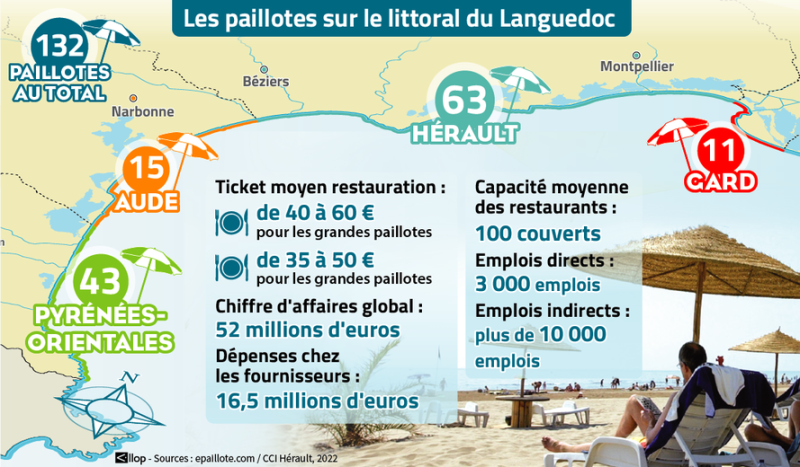Coastline: why the economic weight of seaside huts has become indisputable

Apparues au milieu des années 1990, les paillotes de plage (comme ici La Ola, à Sète) ont très vite trouvé leur public. Avec une réussite incontestable de leur business model. Midi Libre – VINCENT ANDORRA
Present for nearly 40 years on the Languedoc coast, the so-called "developed" have developed a profitable business model. But environmental constraints act as a barrier. Decryption.
Since the appearance, in the mid-1990s, particularly in the Hérault commune of La Grande-Motte, of the first straw huts, private beaches, known, according to the official term, "developed", have continued to develop. To modernize. "The quality increases from year to year, they are more careful", observes Pierre Lapray, Montpellier-based founder of the site epaillote.com, which is celebrating its tenth anniversary this year and which has become the reference in the field.
Their progressive modernization is in line with the development of their activity and attendance, which continues unabated. "Our turnover is growing regularly, but we always have to invest, at the start of each season, since the proximity of the sea undermines our installations and our equipment" , recalls Jean-Michel Mandement, who founded Biquet Plage, in Leucate, in Aude, 18 years ago. He says he invests, each year, "around 40 000 euros".
The restaurant represents 57% of turnover
Despite their economic weight which has become indisputable, little is known about the figures surrounding the activity of seaside huts. In July 2022, the Chamber of Commerce and Industry de l'Hérault had published the only study known to date. It covered 70 of the approximately 80 concessions then recorded in the department. What had we learned on this occasion? That they had a turnover of 52 million euros for a total of 7,000 deckchairs and 5,800 place settings.
Unsurprisingly, the largest share of turnover is achieved with the catering activity. This accounts for 57% of overall turnover, compared to 28% for the bar activity and 15% for the deckchair activity. The weight of the catering activity is all the more significant in the hut business model, as the law requires them to devote 60% of their space (between 1&200 and 1 500 m², depending on the municipality) for deckchairs and 40 % for the bar and catering area.
"We don't want to be jealous"
"We achieve on average, over a season, a figure of 3.2 million euros excluding taxes, for a result of 38& ;nbsp;000 euros, which represents 7 % to 8 %", reveals Pierre-Yves Bricon, boss since 1996 of the Paillote Bambou, in La Grande-Motte. "In Sète, turnover fluctuates on average between 1 and 1.5 million per season", confides Claude Herzog, boss for 25 years of La Ola, on Villeroy beach. He insists on the need to always have good cash flow at the start of the season to ensure the season.
They are among the rare beachgoers to agree to reveal figures. The practice among beach attendants is rather discretionary. "That's understandable, Jean-Michel Mandement intervenes, we don't want to be jealous". "We earn a good living, but we are far from fantasies", adds Pierre-Yves Bricon. "Having good economic results is important when you run a company like ours, which still has 47 employees", slips Claude Herzog.
When the State changes the revenue rule
While most of the time they generate good revenues, the straw huts also have to incur significant expenses. The first of these is the one they must pay to the town hall, under the concession. "There is a fixed portion, which corresponds to the amount that each beach offers to the City during the call for tenders. It is not common, since everyone bids as they wish, explains Claude Herzog. "To this is added another share, corresponding to 1.75 % of the turnover achieved". La Ola beach must therefore pay 86 000 euros per season. "It’is huge", estimates his boss.

"We pass on what the State takes from us", specifies Francis Hernandez, deputy mayor of Sète in charge of beaches. According to our information, the State has collected, since 2023, 30% of the revenue generated on public property by huts. Previously, he was satisfied with a flat rate of 15,000 euros per hut. Data confirmed by the elected official. In Leucate, it’s 10,000 euros and 5% of turnover. In La Grande-Motte, the amount is fixed: around 140,000 euros per season. "The concessions are priced at 120 000 euros, note Pierre-Yves Bricon, then , everyone has their own bid".
"Additional costs are 2 % of turnover"
Finally, the season's bill is weighed down by invisible costs. "We pay, each season, 100 000 euros to build the beach, then the same amount to dismantle it. To this is added a similar sum to store it, in the winter, in a hangar", details Jean-Michel Mandement. "Assembling and dismantling a beach like ours costs between 155 000 and 180 000 euros", adds Pierre-Yves Bricon. "All ancillary costs, it’is 2 % of turnover& quot;.
I subscribe to read more




